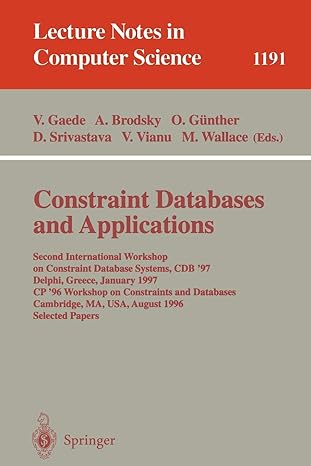Question
Draw an ER Model based on the following information. Please include all relationships, associations, etc.. A small local accounting company would like to create a
Draw an ER Model based on the following information. Please include all relationships, associations, etc..
A small local accounting company would like to create a simplified accounting management system (SAMS). SAMS will keep track of only items that are related to the calculation of income for the office. SAMS, however, will not include other office-related activities such as employee payrolls, purchasing office supplies, office expenses such as travel cost, entertainment or other complex tax-related matters. In the office, there are two types of clients, individual clients or business clients. Individual clients usually pay once a year when they pick up their tax returns. Business clients usually pay the monthly service charge once a month for their routine service. Each business client needs to sign a contract that includes service begin date and a monthly service fee. Once the business client terminates the contract, service ending date is recorded with the status changed into terminated. The monthly service charge is different from one client to another, depending on business type, volume of transactions, and other factors. Business clients may also pay to the office when they receive a special service such as tax audit, special tax preparation, license application, etc. In this office, any item that is paid by clients is called billable items. The fee for a billable item is determined and can be changed only by the owner of the office. For routine services, there are fixed service charge predetermined by the owner. A fee for any special service, not existing in predefined service items, will be determined by the owner case by case. The office sends invoices to business clients once a month by computing the total outstanding balances by summing up all the unpaid or partially-paid billable items. Clients may pay fully, partially, or may not pay on time. If payment is not sufficient for the current outstanding balance, the payment will be applied to the oldest billable items first. The office receives cash, checks, or credit cards. Secretary of the office enters the payments. For a credit card payment, name, address, the last 4 digits of the credit card, expiration date, and the type of the credit card will be stored with the payment information. For check payment, bank name and check number are stored with the payment. SAMS should also be able to generate several reports such as show the payment history of a client, show clients with all the outstanding balances, or show the total billing of this month, show the total payments of this month, etc. For each client, SAMS will also keep track of the total annual billing amounts and total payments for each year for analysis purposes. A billable item is initially called uninvoiced. Once an invoice for the billable item is sent out, the status becomes invoiced. A billable item could also be discounted or canceled. Discounts or cancellation of billable items, however, can only be done by the owner. A client can be searched by one of three ways: either by client number, by last name, or by just browsing the client list. The system shall be password-protected. SAMS will be used by accountants, secretary of the owner, and the owner of the office. Accountants can create new clients, edit client information, and create new billable items. The secretary enter payments, generate invoices and various reports, but cannot create new billable items.
Step by Step Solution
There are 3 Steps involved in it
Step: 1

Get Instant Access to Expert-Tailored Solutions
See step-by-step solutions with expert insights and AI powered tools for academic success
Step: 2

Step: 3

Ace Your Homework with AI
Get the answers you need in no time with our AI-driven, step-by-step assistance
Get Started


